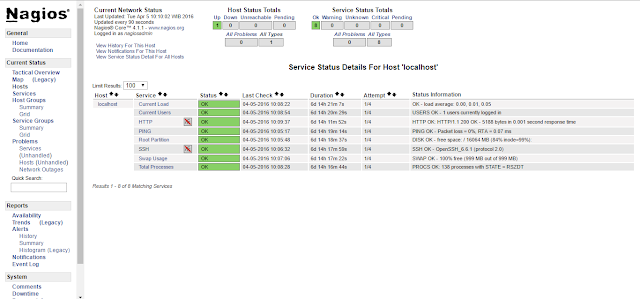What Is Nagios Core:-
Nagios Core is an Open Source system and network monitoring application. It watches hosts and services that you specify, alerting you when things go bad and when they get better.System Requirments:-
1- Linux machine (In my case I am using Centos7.X)
2- HTTPd, PHP with gd and CGI.
Nagios Installation:-
Step 1- Install and setup prerequisites Install Deployment tool
[root@localhost ~]# yum groupinstall "Development Tools"
Install PHP, HTTPD, Pearl and wget
[root@localhost ~]# yum install wget perl httpd php gcc glibc glibc-common gd gd-devel make net-snmp libpng-devel libjpeg-turbo-devel
Create nagios User and group:
[root@localhost ~]# useradd nagios && passwd nagios ##Command to add user and set password ## [root@localhost ~]# groupadd nagcmd ## Command to add group ## [root@localhost ~]# usermod -a -G nagcmd nagios ## command to add nagios user in group nagcmd ## [root@localhost ~]# usermod -a -G nagcmd apache ## Command to add apache user in group nagcmd ##
Step 2- Install and configure Nagios
Download Nagios stable release
[root@localhost ~]# wget https://assets.nagios.com/downloads/nagioscore/releases/nagios-4.2.4.tar.gz
Extract and Configure
[root@localhost ~]# tar zxfv nagios-4.2.4.tar.gz
[root@localhost ~]# cd nagios-4.2.4
Configure Nagios for installation
[root@localhost nagios-4.2.4]# ./configure -with-command-group=nagcmd
Make and install all the configuration files
[root@localhost nagios-4.2.4]# make all
[root@localhost nagios-4.2.4]# make install
[root@localhost nagios-4.2.4]# make install-init
[root@localhost nagios-4.2.4]# make install-commandmode
[root@localhost nagios-4.2.4]# make install-config
[root@localhost nagios-4.2.4]# make install-webconf
Copy eventhandlers and set permission
[root@localhost nagios-4.2.4]# cp -R contrib/eventhandlers/ /usr/local/nagios/libexec/
[root@localhost nagios-4.2.4]# chown -R nagios:nagios /usr/local/nagios/libexec/eventhandlers
Copy Check Nagios configuration and add Nagios login credentials [root@localhost nagios-4.2.4]# /usr/local/nagios/bin/nagios -v /usr/local/nagios/etc/nagios.cfg Nagios Core 4.2.4 Copyright (c) 2009-present Nagios Core Development Team and Community Contributors Copyright (c) 1999-2009 Ethan Galstad Last Modified: 12-07-2016 License: GPL Website: https://www.nagios.org Reading configuration data... Read main config file okay... Read object config files okay... Running pre-flight check on configuration data... Checking objects... Checked 8 services. Checked 1 hosts. Checked 1 host groups. Checked 0 service groups. Checked 1 contacts. Checked 1 contact groups. Checked 26 commands. Checked 5 time periods. Checked 0 host escalations. Checked 0 service escalations. Checking for circular paths... Checked 1 hosts Checked 0 service dependencies Checked 0 host dependencies Checked 5 timeperiods Checking global event handlers... Checking obsessive compulsive processor commands... Checking misc settings... Total Warnings: 0 Total Errors: 0
[root@localhost nagios-4.2.4]# htpasswd -c /usr/local/nagios/etc/htpasswd.users nagiosadmin New password: ********* Re-type new password: ********* Adding password for user nagiosadmin
Install Nagios Plugins and NRPE client
[root@localhost nagios-4.2.4]# yum install nagios-plugins-all nagios-plugins-nrpe
Update Firewall-cmd and allow http access
[root@localhost nagios-4.2.4]# firewall-cmd --permanent --add-service=http
[root@localhost nagios-4.2.4]# firewall-cmd --reload
Change plugins access user from this file "usr/local/nagios/etc/resource.cfg"
[root@localhost nagios-4.2.4]# vi /usr/local/nagios/etc/resource.cfg
Made changes as follow# Sets $USER1$ to be the path to the plugins
#$USER1$=/usr/local/nagios/libexec
$USER1$=//usr/lib64/nagios/plugins
# Sets $USER2$ to be the path to event handlers
#$USER2$=/usr/local/nagios/libexec/eventhandlers
Enable Nagios and httpd service to start at boot time
[root@localhost nagios-4.2.4]# systemctl enable httpd && systemctl enable nagios
Now reload httpd and nagios service[root@localhost nagios-4.2.4]# systemctl restart httpd && systemctl restart nagios
Installation and configuration part completed successfully.
Let's check through URL: http://192.168.102.11/nagios/
!!! Congrats Nagios 4.x installation and configuration part completed successfully !!!
In the next blog we will learn how to configure pnp4nagios to generate graph and view usage of resource whenever needed.

thank you so much, excellent manual but i had a problem installing the plugins, i used yum install nagios-plugins-all and nagios-plugins-nrpe and the package source says: no package avaliable.
ReplyDeleteBut i used this:
wget http://nagios-plugins.org/download/nagios-plugins-2.0.3.tar.gz
tar xzf nagios-plugins-2.0.3.tar.gz
cd nagios-plugins-2.0.3
./configure --with-nagios-user=nagios --with-nagios-group=nagios
make
make install
ant then continue with your manual.
hope you answer my comment.
Thank You!
Could you please let me know what CentOS version you have? or you can try run this command - yum groupinstall "Development Tools"
DeleteI have this version CentOS-7-x86_64-DVD-1611.iso ; and I already install Development Tools.
ReplyDeletePlease share output of "yum repolist"
DeleteLoaded plugins: fastestmirror, langpacks
ReplyDeleteLoading mirror speeds from cached hostfile
* base: mirrors.ucr.ac.cr
* extras: mirrors.ucr.ac.cr
* updates: ftp.unicamp.br
repo id repo name status
base/7/x86_64 CentOS-7 - Base 9,363
extras/7/x86_64 CentOS-7 - Extras 447
updates/7/x86_64 CentOS-7 - Update 2100
repolist: 11,910
Please add epel repo by command below-
Delete"yum install epel-release"
Then try to install NAGIOS plugin
Ok let me try.
ReplyDeleteDone! Thank you so much.
ReplyDeleteSo I have a Q, do you have information about Nagios4,Pnp4, and nagiosql working in CentOS7.x?
I'm looking for information, how to configure those service in the same server.
Try This-- First one you Already done, Go for Number 2 for PnP4 integration
DeleteInstall and configure Nagios4.x- https://linuxhowtoguide.blogspot.ca/2017/03/how-to-install-and-configure-nagios-4x.html
Congigure PnP4 - https://linuxhowtoguide.blogspot.ca/2017/03/how-to-install-and-configure-pnp4nagios.html
Thank, i just need nagiosql.
ReplyDeleteThank you very much.
I did not create my own NagiosQL document yet, but i will work on this section too. for now you can use this link -
Deletehttps://tecadmin.net/install-nagiosql-with-nagios-core-on-centos-rhel/
I am not sure about it, but seems it should work as expected.